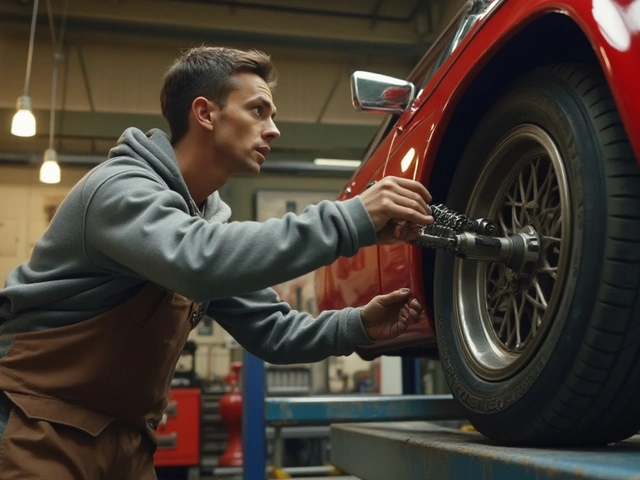If you're thinking about modding your car with lowering springs, you might be wondering if shorter shocks are part of the deal. It's a common question and one that can make or break the ride quality of your beloved vehicle. Let's face it: none of us want a jarring, uncomfortable ride, no matter how cool the car looks.
Lowering springs are all about aesthetics and performance, giving your car a sleek stance while improving handling. But they also change the dynamics of your suspension setup. This is where the debate about shorter shocks comes in. Typically, lowering springs reduce the distance that your suspension travels. So, do shorter shocks help? Or are they just another item on the wishlist?
- Why Lowering Springs Matter
- Shorter Shocks: Necessity or Nicety?
- Balancing Ride Quality and Performance
- Practical Tips and Considerations
Why Lowering Springs Matter
So, why do lowering springs get so much buzz in the car modding community? It's simple—they offer a blend of style and substance that can transform the driving experience.
Better Handling
By decreasing a car’s ride height, lowering springs reduce the center of gravity. This can make a significant difference in cornering performance. Your vehicle feels more stable and nimble, especially when you're taking sharp turns.
"Lowering your car can enhance handling due to a reduced center of gravity," says Alex Thompson, an auto tech with over 20 years of experience.
Aesthetic Appeal
There's no denying the visual appeal of a lowered car. It can turn heads in any parking lot. The stance looks sportier and more aggressive, whether you're at a car meet or just running errands. Plus, the snug fit between the wheel and fender can make your car look as if it rolled off a custom line.
Improved Aerodynamics
With the car sitting closer to the ground, there's less air resistance hitting the underbody. This could lead to better fuel efficiency and slightly enhanced speed—good news for those weekend track days.
Despite these perks, it's not all about immediate benefits. There are considerations too, like potential uneven tire wear or ground clearance issues. Regardless, many car enthusiasts find that the improvements to performance and appearance make lowering springs worth their while.
Shorter Shocks: Necessity or Nicety?
So, are shorter shocks a must when you drop your ride with lowering springs? The answer often depends on what you're aiming for and how low you're going. Shorter shocks aren't always mandatory, but they can make a big difference.
Lowering springs change the suspension geometry, which means your factory shocks may not work optimally. When the springs are shorter, the shock pistons end up in a lower position within the shock tube. This affects the damping performance, mainly because you lose much of that initial shock travel.
Enhanced Performance
Shorter or performance shocks are designed to match the reduced height of lowering springs, which means they maintain their full range of motion and better handle the altered suspension dynamics. This combo enhances both the ride quality and handling, often giving you both smoother and sportier rides.
Cost versus Benefits
So here's the crux: do you need to spend extra money for shorter shocks? While they can be more expensive, the improvement in performance and ride quality might be worth it. A well-matched setup can prevent bottoming out or uneven tire wear.
When Can You Do Without Them?
However, if you're not dropping your car too low—let's say by an inch or so—your existing shocks might just support that change. But remember, it varies widely between different car makes and models. Always check manufacturer specs and consult with a specialist.
Wrapping Up
In the world of car mods, knowledge is power. Understanding how car suspension components work together helps you make informed decisions. While shorter shocks may not be a necessity for everyone, they offer several advantages that ensure your car doesn't just look good but drives well, too.

Balancing Ride Quality and Performance
When it comes to car mods, achieving the sweet spot between ride quality and performance is key. You don't just want a car that looks killer; you want one that feels just right, too. So how does pairing lowering springs with the right shocks affect your ride?
First off, lowering springs can increase handling performance by lowering your car's center of gravity. But here's the catch: they can also make the ride stiffer by reducing suspension travel. Now, if you throw in shorter shocks, the idea is to match the suspension's new characteristics better, ensuring a smoother, more predictable ride.
What Happens If You Keep Stock Shocks?
Using stock shocks with lowering springs can sometimes lead to a bouncy, uncomfortable ride, and it may even wear out the shocks prematurely. In some cases, the suspension could bottom out more easily. It's like fitting into shoes that are a size too big; they kind of fit, but it's not the best for comfort or function.
The Benefits of Shorter Shocks
By switching to shorter, or rather optimized, shocks, you ensure that the shocks work within their intended range. This alignment helps in absorbing bumps better while maintaining the handling improvements you've achieved with the lowering springs. Essentially, shorter shocks are designed to handle the reduced travel more efficiently, improving the ride and durability of your car's suspension.
Fast Facts: Performance vs. Comfort
- Lowering springs typically lower your car's height by 1 to 3 inches.
- Shorter shocks can increase shock lifespan by 15-30% when paired correctly.
- A well-balanced setup can reduce overall vehicle instability during high-speed maneuvers.
Ultimately, the decision boils down to what you want out of your vehicle. Are you going for that racy feel, or do you still want to keep things comfy on the day-to-day drive? Whichever way you lean, understanding these dynamics can help you make a decision that keeps both aesthetics and performance in line. After all, who said you can't have your cake and eat it too?
Practical Tips and Considerations
So you're leaning towards installing lowering springs but want to be sure you're making the right call with your shocks? No worries, here are some practical insights to guide you through this.
Check Compatibility
First off, before making any decisions, ensure your chosen lowering springs are compatible with your car. Mismatched components can lead to issues down the road, and nobody wants that. Always double-check compatibility information provided by manufacturers.
Consider Current Suspension Health
Think about the condition of your existing shocks and struts. If they're showing wear and tear, it might be a good time to swap them for shorter shocks. This move might enhance your vehicle's overall handling and ride consistency.
Mind the Ride Quality
Lowered cars look fantastic, but slamming them too much can make for a bumpy ride. If daily comfort and passenger smiles are high on your priority list, consider some cushioning options like progressive-rate springs that give a balanced ride.
Don’t Forget the Alignment
After changing your springs, getting a proper alignment is key. Poor alignment can affect handling and tire wear. Save yourself future hassle by making it a step in your upgrade process.
Use Trusted Brands
When it comes to car suspension parts, you get what you pay for. Trusted and reviewed brands might cost a bit more, but they provide the quality and durability your ride deserves.
Budget Wisely
Finally, don't overlook your budget. Extending it a bit for a total setup upgrade can be wiser than getting stranded with mismatched parts. Weigh costs with benefits to find the sweet spot.
By considering these factors, you'll navigate your way to a better driving experience without the headache. Whether you opt for shorter shocks or stick with your current setup, these tips will help keep you steady on the road.




